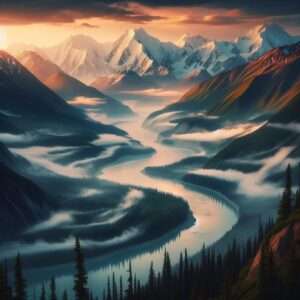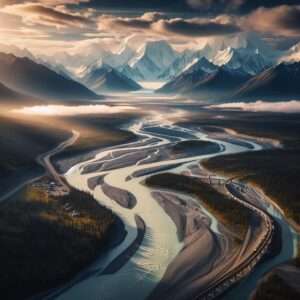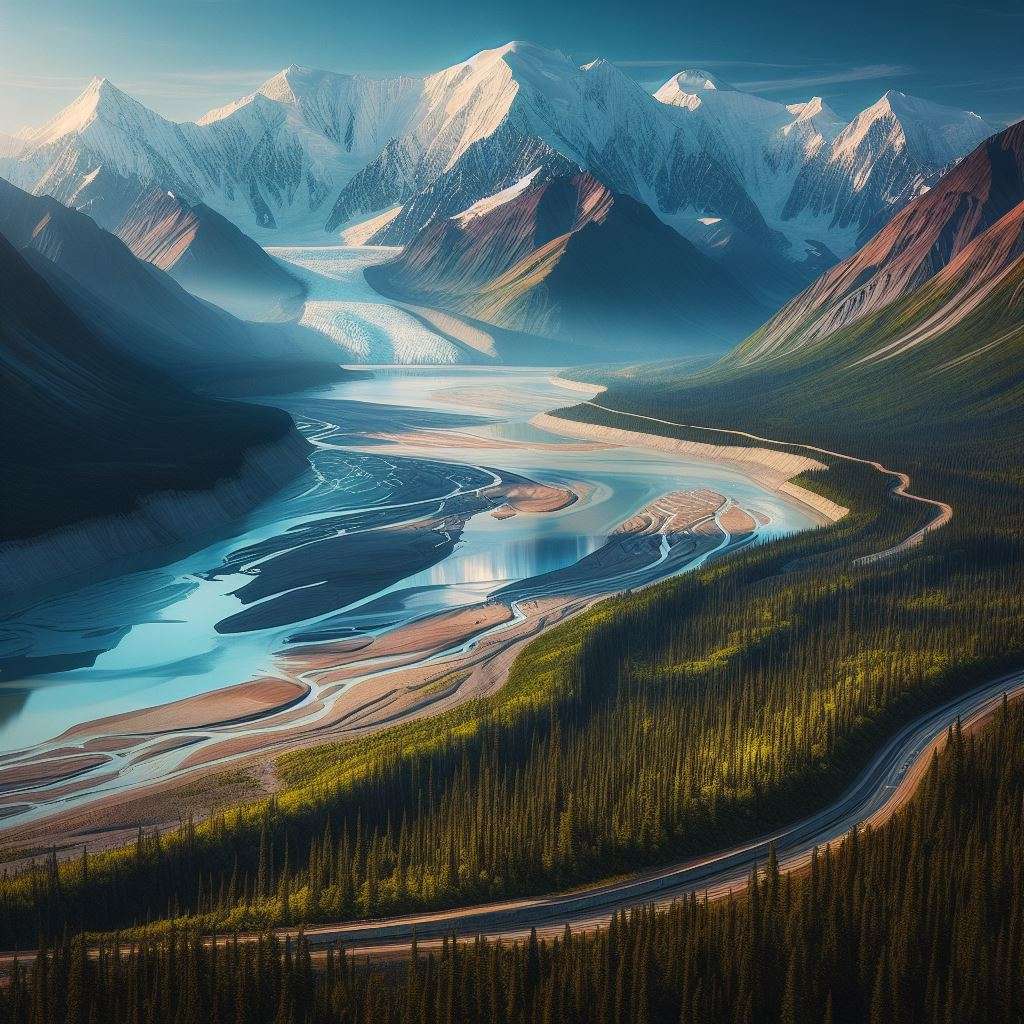Wrangell-St. Elias National Park and Preserve: 10 Enchanting Reasons to Explore Alaska’s Wilderness Wonderland
Introduction
Welcome to the untamed beauty of Wrangell-St. Elias National Park and Preserve – a land where wilderness reigns supreme and the spirit of adventure beckons at every turn. Nestled in the heart of Alaska, this sprawling expanse is not just a national park; it’s a breathtaking tapestry of glaciers, towering peaks, and ancient cultural tales waiting to be discovered.
Imagine a place where the air is crisp with the scent of pine, and the horizon stretches endlessly, inviting you to explore its secrets. In this blog, we invite you on a virtual journey through the wonders of Wrangell-St. Elias, sharing stories of epic landscapes, wildlife encounters, and the rich tapestry of history that makes this national park and preserve a true Alaskan gem.
So, lace up your virtual hiking boots, grab your sense of wonder, and join us as we uncover the magic of Wrangell-St. Elias – a wilderness so vast, it will leave you in awe at every turn. Get ready for an adventure that transcends the ordinary and immerse yourself in the extraordinary beauty of America’s largest national park and preserve.
Attractions in Wrangell-St. Elias National Park and Preserve:
Displayed in the table below are the leading 25 attractions within Wrangell-St. Elias National Park and Preserve, highlighting distinctive features that distinguish each site and render it remarkable.
| # | Attraction | What’s Special |
|---|---|---|
| 1 | Mount St. Elias | Second-highest peak in the United States. |
| 2 | Nabesna Road | Scenic drive with stunning mountain views. |
| 3 | Kennecott Mines | Historic copper mining town and abandoned mines. |
| 4 | Root Glacier | Accessible glacier for hiking and ice climbing. |
| 5 | McCarthy | Charming town with art galleries and local history. |
| 6 | Wrangell Mountains Center | Community center promoting art and science. |
| 7 | Kennicott Glacier Lodge | Lodging with breathtaking glacier views. |
| 8 | Matanuska Glacier | Accessible glacier for guided tours and ice exploration. |
| 9 | Chitina River | Scenic river with fishing and wildlife viewing. |
| 10 | Wrangell-St. Elias Visitor Center | Information center with exhibits and ranger programs. |
| 11 | Mt. Drum | Prominent peak in the Wrangell Mountains. |
| 12 | Donoho Peak | Hiking destination with panoramic views. |
| 13 | Copper River | Major river with salmon runs and fishing opportunities. |
| 14 | Kennecott Copper Mine | Abandoned copper mine with historical significance. |
| 15 | Goat Trail | Hiking trail offering wildlife sightings. |
| 16 | Kuskulana Bridge | Historic bridge along the McCarthy Road. |
| 17 | Tebay Lakes Trail | Trail leading to pristine alpine lakes. |
| 18 | Icy Bay | Coastal bay with stunning glacial scenery. |
| 19 | Nelchina Glacier | Remote glacier accessible by air tours. |
| 20 | Liberty Falls | Scenic waterfall in the Wrangell Mountains. |
| 21 | Yakutat Bay | Breathtaking bay with tidewater glaciers. |
| 22 | Wrangell St. Elias Wilderness | Expansive wilderness area for backcountry adventures. |
| 23 | Mt. Blackburn | Fourth-highest peak in the United States. |
| 24 | Chugach Mountains | Mountain range with diverse ecosystems and wildlife. |
| 25 | Kennicott River | Scenic river with opportunities for rafting and fishing. |

General Information:
What sets Wrangell-St. Elias National Park and Preserve apart from other national parks?
Wrangell-St. Elias National Park and Preserve stands out for its vastness, diverse ecosystems, and the towering peaks of the Wrangell and St. Elias mountain ranges. It holds the title of the largest national park in the United States, offering an unparalleled expanse of wilderness. The park’s combination of glaciers, mountains, and unique cultural history creates a distinctive and immersive experience for visitors.
Can you share some key details about Wrangell-St. Elias National Park and Preserve in Alaska?
Nestled in the remote corners of Alaska, Wrangell-St. Elias National Park and Preserve spans over 13 million acres, encompassing a mesmerizing blend of natural wonders. From the icy slopes of its colossal mountains to the rich cultural heritage of its indigenous people, the park tells a captivating story of Alaska’s untamed beauty. Visitors can explore the ancient landscapes that have shaped the region’s history and experience the wild grandeur that defines this extraordinary national park.
What makes the mines in Wrangell-St. Elias National Park and Preserve unique?
Wrangell-St. Elias National Park and Preserve holds remnants of historic mines, adding a fascinating layer to its diverse tapestry. The park’s mining history, particularly in areas like Kennecott, reflects the pursuit of wealth during Alaska’s gold rush era. Today, the abandoned mines serve as a testament to the challenges and aspirations of the past, providing a unique historical perspective amid the park’s pristine wilderness.
How does Wrangell-St. Elias National Park and Preserve contribute to Alaska’s natural beauty?
Wrangell-St. Elias National Park and Preserve is a cornerstone of Alaska’s natural beauty, contributing to the state’s reputation as a haven for outdoor enthusiasts. The park’s glaciers, including the famous Kennicott Glacier, showcase the raw power of ice carving through the rugged terrain. Additionally, its vast landscapes, teeming with diverse flora and fauna, contribute to the overall richness of Alaska’s ecosystems.
Visual Exploration:
Where can I find a captivating collection of photos showcasing Wrangell-St. Elias National Park and Preserve?
Captivating photos of Wrangell-St. Elias National Park and Preserve can be discovered on various platforms, including official park websites, photography forums, and travel blogs. These visual treasures capture the park’s stunning landscapes, wildlife encounters, and the unique juxtaposition of ice and rock that defines its visual allure. Online platforms provide a glimpse into the park’s grandeur, enticing potential visitors to embark on their own exploration.
Is there an interactive map available for exploring Wrangell-St. Elias National Park and Preserve?
Yes, an interactive map for Wrangell-St. Elias National Park and Preserve is readily available on official park websites and at visitor centers. This map serves as a valuable tool for planning and navigating the expansive park. It highlights key points of interest, trails, and important information about the park’s diverse features, empowering visitors to make the most of their exploration.
Visitor Experience:
What types of guided tours are offered for visitors to Wrangell-St. Elias National Park and Preserve?
Wrangell-St. Elias National Park and Preserve provides a range of guided tours, allowing visitors to delve into specific aspects of the park’s wonders. These tours may focus on the historical significance of Kennecott Mines, the exploration of unique ecosystems, or wildlife observation in designated areas. Expert guides enhance the visitor experience, offering insights into the park’s natural and cultural heritage.
Are there any standout reviews that highlight the visitor experience in Wrangell-St. Elias National Park and Preserve?
Reviews of Wrangell-St. Elias National Park and Preserve often highlight the awe-inspiring landscapes and the sense of remoteness that sets it apart. Visitors share their experiences of witnessing glaciers, encountering diverse wildlife, and exploring the rich history of the region. The standout reviews often emphasize the park’s ability to provide a true wilderness adventure, immersing visitors in the raw beauty of Alaska.
How can I secure tickets for entry into Wrangell-St. Elias National Park and Preserve?
Tickets for entry into Wrangell-St. Elias National Park and Preserve can typically be obtained at park entrance stations or visitor centers. The park operates on a fee system, with fees varying based on the type of entry, including individual or vehicle passes. Visitors can also explore options for annual passes, providing access to this vast wilderness for an extended period.
Tell me about the camping options available within Wrangell-St. Elias National Park and Preserve.
Wrangell-St. Elias National Park and Preserve offers various camping options, ranging from established campgrounds to backcountry camping for those seeking a more immersive experience. Campgrounds like the one near the historic Kennecott Mines provide essential amenities, while backcountry camping allows adventurers to connect with the pristine wilderness. Permits may be required for backcountry camping to ensure a minimal impact on the environment.

Location and Trails:
Can you provide specific details about the location of Wrangell-St. Elias National Park and Preserve? – Wrangell-St. Elias National Park and Preserve is located in southeastern Alaska, spanning an immense area that includes portions of the Wrangell and St. Elias mountain ranges. The park’s boundaries extend from the Gulf of Alaska to the Canadian border, showcasing a diverse range of ecosystems. Its remote location adds to the park’s allure, providing a true escape into the heart of the Alaskan wilderness.
What are some notable trails that visitors can explore in Wrangell-St. Elias National Park and Preserve?
Wrangell-St. Elias National Park and Preserve boasts a network of trails catering to various skill levels and interests. Notable trails include the Root Glacier Trail, offering stunning views of the Kennicott Glacier, and the Bonanza Mine Trail, which provides a historical perspective on the region’s mining past. These trails allow visitors to traverse diverse landscapes, from lush forests to glacier-carved valleys.
National Parks Connection:
How does Wrangell-St. Elias National Park and Preserve connect and collaborate with other national parks in the region? – Wrangell-St. Elias National Park and Preserve collaborates with neighboring parks to address shared challenges and initiatives. The interconnected nature of Alaska’s national parks encourages collaboration in areas such as conservation efforts, research projects, and the promotion of responsible tourism. This cooperative approach ensures a holistic approach to preserving the unique natural and cultural heritage of the region.
Are there any shared initiatives or projects between Wrangell-St. Elias National Park and Preserve and neighboring national parks?
Yes, Wrangell-St. Elias National Park and Preserve engages in shared initiatives and projects with neighboring national parks to enhance the overall conservation efforts in the region. This collaborative approach may include scientific research, educational programs, and initiatives aimed at promoting sustainable practices. The synergy between parks contributes to a comprehensive and unified strategy for protecting the diverse ecosystems of Alaska.
Alaska’s Heritage:
In what ways does Wrangell-St. Elias National Park and Preserve contribute to preserving Alaska’s heritage? – Wrangell-St. Elias National Park and Preserve plays a vital role in preserving Alaska’s heritage by conserving both natural and cultural aspects of the region. The park’s commitment to protecting historical sites, such as the Kennecott Mines, ensures that the stories of Alaska’s past are safeguarded for future generations. Additionally, the park collaborates with local communities to celebrate and share the rich cultural heritage of Alaska’s indigenous peoples.
Are there cultural or historical sites within Wrangell-St. Elias National Park and Preserve that visitors can explore?
Wrangell-St. Elias National Park and Preserve is home to several cultural and historical sites, with the Kennecott Mines being a prominent example. These mines, now abandoned, provide a glimpse into Alaska’s mining history during the early 20th century. Visitors can explore the well-preserved structures and artifacts, gaining insight into the challenges and triumphs of those who once called this remote wilderness home.

Wildlife and Ecosystems:
What types of wildlife can be encountered in the diverse ecosystems of Wrangell-St. Elias National Park and Preserve? – Wrangell-St. Elias National Park and Preserve supports a rich array of wildlife due to its diverse ecosystems. Visitors may encounter grizzly bears, moose, Dall’s sheep, and a variety of bird species. The park’s pristine habitats, including forests, tundra, and glaciers, contribute to the flourishing biodiversity, providing ample opportunities for wildlife enthusiasts to observe and appreciate the natural beauty of the region.
How does the park support biodiversity, and are there any conservation efforts in place?
Wrangell-St. Elias National Park and Preserve actively supports biodiversity through conservation efforts aimed at preserving the park’s unique ecosystems. The park’s vast and relatively undisturbed landscapes provide essential habitats for a diverse range of plant and animal species. Conservation initiatives focus on maintaining the delicate balance of these ecosystems, addressing potential threats, and conducting research to better understand and protect the biodiversity within the park.
Climate and Seasons:
What is the typical climate in Wrangell-St. Elias National Park and Preserve, and how does it vary across seasons? – Wrangell-St. Elias National Park and Preserve experiences a subarctic climate characterised by cold winters and short, mild summers. Winters can be harsh, with temperatures often dropping below freezing, while summers offer a brief respite with temperatures ranging from 40 to 70 degrees Fahrenheit. The park’s climate significantly influences the seasonal activities and experiences available to visitors.
Are there specific activities or events that align with different seasons in Wrangell-St. Elias National Park and Preserve?
The seasonal changes in Wrangell-St. Elias National Park and Preserve offer a dynamic range of activities for visitors. Summer provides opportunities for hiking, wildlife observation, and exploring the park’s historic sites. Winter opens up possibilities for snowshoeing, cross-country skiing, and experiencing the enchanting beauty of the park blanketed in snow. Each season brings its own unique charm and adventure to those exploring the diverse landscapes of the park.
Accessibility:
How can visitors best access Wrangell-St. Elias National Park and Preserve, considering its remote location? – Accessing Wrangell-St. Elias National Park and Preserve requires careful planning due to its remote location. While there are no direct roads leading into the park, visitors can reach nearby towns like McCarthy or Kennecott by road. From there, transportation options, including shuttles
Exploring Wrangell-St. Elias National Park and Preserve: Your Comprehensive Guide to Adventure and Discovery
What makes Wrangell-St. Elias National Park and Preserve unique among national parks?
Wrangell-St. Elias stands out as the largest national park in the United States, showcasing a diverse range of landscapes, from towering peaks to expansive glaciers, and rich cultural history.
How do I access Wrangell-St. Elias National Park and Preserve?
Accessing the park involves careful planning due to its remote location. Most visitors fly into nearby towns like McCarthy or drive to specific entry points, requiring additional transportation to reach the park’s interior.
What are the must-see features within Wrangell-St. Elias National Park and Preserve?
Key highlights include the massive Malaspina Glacier, the historic Kennecott Mines, and the towering peaks of the Wrangell and St. Elias mountain ranges.
Are there guided tours available for exploring Wrangell-St. Elias National Park and Preserve?
Yes, various guided tours offer insights into the park’s natural wonders, cultural heritage, and unique features. From glacier hikes to wildlife observation, guided tours enhance the overall visitor experience.
Tell me about the camping options within Wrangell-St. Elias National Park and Preserve.
The park provides camping opportunities, with designated campgrounds and backcountry options. Visitors should be well-prepared, as facilities are limited, and the wilderness experience is emphasized.
What is the best time to visit Wrangell-St. Elias National Park and Preserve?
The summer months, from June to August, offer more accessible conditions with milder temperatures, making it an ideal time for exploration, wildlife observation, and outdoor activities.
Can I find educational programs or resources in Wrangell-St. Elias National Park and Preserve?
Yes, the park offers educational initiatives, including ranger-led programs, interpretive exhibits, and informational materials, providing visitors with a deeper understanding of the park’s natural and cultural significance.
What wildlife can be encountered within Wrangell-St. Elias National Park and Preserve?
The park is home to diverse wildlife, including bears, moose, caribou, and numerous bird species. Wildlife enthusiasts will find ample opportunities for observation within the park’s vast and varied ecosystems.
How does Wrangell-St. Elias National Park and Preserve contribute to conservation efforts?
The park actively engages in conservation initiatives to protect its unique ecosystems and cultural heritage. Efforts include habitat preservation, wildlife monitoring, and educational programs focused on sustainable practices.
Are there cultural or historical sites to explore within Wrangell-St. Elias National Park and Preserve?
Yes, the historic Kennecott Mines, once a thriving copper mining town, offer a glimpse into the region’s industrial past. Additionally, the park preserves the cultural heritage of the native Athabascan people.
You may also consider discovering information about Grand Teton National Park.

